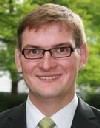Liens vers les séminaires de 2021, 2020, 2019, 2018, 2017, 2016, 2015, 2014, 2013, 2012, 2011, 2010
Voir aussi la liste des « Réunions de Travail et d’Echange » du Département MIS.
26/11/2015 : Dr. Innocent Niyonzima (TU Darmstadt)
 ECL,Bât. E6 (2ème étage), 14h30
ECL,Bât. E6 (2ème étage), 14h30
Ce séminaire est proposé en collaboration avec l’Institut Camille Jordan. Il aura lieu en salle de conférence du département de mathématiques, bâtiment E6.
Multiscale modeling and Time Domain Parallelization for Magnetoquasistatic Problems.
Two topics with the potential of reducing the computational cost of
numerical methods for magnetoquasistatic problems are addressed in this
talk: the FE multiscale modeling and the time domain parallelization
methods.
FE multiscale modeling is developed for handling magnetoquasistatic problems involving composite materials. The method is inspired by the HMM (heterogeneous multiscale method), which involves the resolution of two types of problems: a macroscale problem that captures slow variations of the overall solution, and many mesoscale problems that allow to determine the constitutive laws at the macroscale and to construct accurate local fields. Macroscale and mesoscale weak formulations are derived from the asymptotic homogenization theories. Scale transitions used for bridging the scales are treated as well. Numerical tests on soft magnetic composites allow to validate the model.
A time domain parallelization method for solving equations that govern eddy currents problems is presented. This method, inspired from the “Parareal” method, relies on the same principle as the domain decomposition method, i.e., the splitting the time interval into N sub-intervals (N being the number of CPUs) and the use of an appropriate fine operator for computing accurate solutions on each CPU and of a coarse operator for approximating accurate initial conditions for each sub-interval. Preliminary results will be presented.
I. Niyozima est docteur de l’Université de Liège (promoteur : C. Geuzaine), actuellement en post-doc dans l’équipe de Herbert de Gersem à la TU Darmstadt.
27/11/2015 : Dr. Aude Silve (Institut de technologie de Karlsruhe)
 ECL, H9, salle de conférences.
ECL, H9, salle de conférences.
Travaux autour de l’électroporation.
Aude Silve travaille depuis trois ans à l’institut de technologie de Karlsruhe. Ses travaux portent notamment sur la mesure à l’échelle de la cellule du potentiel transmembranaire lors de l’application de pulses électriques. L’approche qu’elle met en œuvre repose sur l’utilisation d’un marqueur (ANNINE-6) dont la fluorescence émise dépend du potentiel vu. La technique est prometteuse puisqu’elle permet une résolution temporelle fine (5 ns) ; par contre, il y a des problèmes de calibration qui font qu’il est à ce jour difficile de traduire les images de fluorescence en termes de différence de potentiel absolue.
24/11/2015 : Sérgio Waitman (Doctorant Ampère)
 ECL, H9, 12h30 (PhD Club) - Diaporama de présentation
ECL, H9, 12h30 (PhD Club) - Diaporama de présentation
A piecewise affine approach to nonlinear performance
The widespread concepts of Lyapunov and L2-gain stability are reviewed and applied to piecewise affine systems and differential inclusions. These classical results are shown to be insufficient to guarantee some qualitative specifications related to design problems concerning tracking, synchronization and observer design. The incremental framework is proposed to cope with these limitations, and its basic concepts are reviewed, as well as different approaches to the assessment of incremental L2-gain stability.
05/11/2015 : Prof. Alexandre Trofino NETO (UFSC, Brésil)
Switching rule design for affine switched systems with guaranteed cost and uncertain equilibrium condition
This talk addresses the problem of determining switching rules for affine switched systems such that the system state is driven to a desired point and a guaranteed cost is minimized. The switching rule is determined by solving an LMI problem and global asymptotic stability of the tracking error dynamics is guaranteed even if sliding motions occur on any switching surface of the system. The potential of the results is illustrated on a true refrigeration system, namely a domestic refrigerator, where the purpose is to control the temperature in the fresh food and the freezer compartments.
Alexandre Trofino (CV complet) est docteur de l’INP (Grenoble) en 1993. Il a fait des séjours sabbatiques longs à l’INRA (Narbonne), à l’Université de Sydney et à l’Université de Californie à San Diego. Il est Professeur à l’UFSC.
Rappelons que l’UFSC (Université Fédérale de Santa Catarina) est l’un des 3 Etablissements brésiliens membres du LIA Maxwell. Deux de nos anciens doctorants y sont enseignants (Moises Ferber, thèse 2013, et Xisto Lucas Travassos, thèse 2007).
20/10/2015 : Khaled LAIB
ECL, H9 (PhD Club) - diaporama de présentation
Distributed Hierarchical Performance Analysis of Uncertain Large Scale Systems
Large scale systems (LSS) such as networks or interconnected systems have become important nowadays. With the technological development and the miniaturization of components, high complexity systems are designed in order to achieve a high level of performance, see e.g. Phase Locked Loop (PLL) networks in synchronous multi-core microprocessor systems.
However, during the fabrication process, technological dispersions, system ageing, etc. could dramatically a-ect the performance level. Therefore it is crucial to a priori ensure that the desired level of performance is obtained when the system is realized. Since the -rst step of the design is to obtain a mathematical model of the system, the di-erences between the realized system and the model can be expressed as an uncertain model. Ensuring a certain level of performance then reduces to a worst case performance analysis problem (robustness analysis). Robustness analysis investigates the stability and the performance of uncertain Linear Time Invariant (LTI) models. Within this framework, even if the underlying problem is NP hard, many e-cient methods have been developed based on relaxations as convex optimization problems under Linear Matrix Inequality (LMI) constraints, see e.g. the - upper bound in the —analysis approach or the Integral Quadratic Constraint (IQC) approach. Nevertheless, these methods can not be practically applied to uncertain large scale systems since the computation time of the robustness analysis becomes dramatically important.
In this presentation, we will show and discuss an alternative method to investigate the performance of the uncertain large scale system. The hierarchical analysis method considers the hierarchical structure of the LSS to investigate its performance using IQC propagation. This method decomposes the complex and large size analysis problem into several simpli-ed and small size analysis problems that can be investigated separately (distributed analysis). This method will be illustrated with a real problem of the PLL network performance analysis. An other academic example will be used to illustrate the advantage of this apparaoch and its di-erent degrees of freedom.
15/10/2015 : Paul Kotyczka (TU Munich)
Local linear dynamics assignment – a technique for controller parametrization in passivity based control
Energy based control design techniques, which either exploit the physical structure of a dynamical system or try to impose a physically inspired form of the differential equations have been discussed for the last 20 years. The central arguments in these methods are the shaping of an (artificial) closed-loop energy and the injection of appropriate damping. Both from the Lagrangian and the Hamiltonian point of view, a variety of – generically nonlinear – approaches for stabilization and regulation has been developed, either using dynamic output feedback with closed-loop invariants (Casimir functions) or a full state feedback. Being conceptually intuitive, a major difficulty in energy based control designs is the transparent choice of design parameters to achieve desired transient behavior. In this talk, a solution to cope with this problem is presented in the context of the Interconnection and Damping Assignment Passivity Based Control (IDA-PBC) method for state feedback of finite-dimensional systems. The free parameters in the physically inspired interconnection, damping and energy terms are fixed using prescribed dynamics of the closed-loop linearization. Byproducts of the approach are a clear order of the design steps, the classification of different design quantities and the omission of the tedious positivity check of the closed-loop energy function.
14/10/2015 : Hassan Omran (ATER ECL)
 ECL - Bâtiment H9 - diaporama de présentation
ECL - Bâtiment H9 - diaporama de présentation
Stability analysis of some classes of input-affine nonlinear systems with aperiodic sampled-data control
In this work we investigate the stability analysis of nonlinear sampled-data systems, which are affine in the input. We assume that a controller is designed using the emulation technique, thus it is designed in continuous-time and then implemented digitally. We intend to provide sufficient stability conditions for the resulting sampled-data system. This allows to find an estimate of the upper bound on the asynchronous sampling intervals, for which stability is ensured. The main idea of the paper is to address the stability problem in a framework inspired by the dissipativity theory. Furthermore, the result is shown to be constructive. Numerically tractable criteria are derived using linear matrix inequality for polytopic systems, and using sum of squares technique for the class of polynomial systems.
25/06/2015 : Prof. Jose A. Antonino-Daviu (Valence, Espagne)
Application of wavelet transforms to electric motor fault diagnosis.
Signal processing tools have lived a spectacular development over recent decades. More specifically, wavelet transforms have shown very satisfactory results in many scientific areas, when analyzing non-stationary signals. Recently, the use of these tools was extended to the electric motor condition monitoring area. It has been proven that the analysis of non-stationary machine quantities (currents,vibrations?) by using wavelet transforms can provide very clear pictures that reliably inform about the machine health condition. In this context, the analysis of the motor startup current with such tools has been proven to be a very reliable way to diagnose several types of faults as rotor failures or eccentricities. This seminar is aimed to provide an overview of the application of different wavelet transforms in the electric motor condition monitoring area. Application of both Discrete and Continuous wavelet transforms will be considered. The results obtained with real industrial signals will show the advantages of the use of these tools versus other methodologies that are widespread in industry.
22/06/2015 : Florent Di Meglio (Mines ParisTech)
INSA St-Ex.
Boundary control design of linear hyperbolic systems.
We present a control design for a large class of linear first-order hyperbolic systems. The systems feature an arbitrary number of states traveling in either direction. In the case of heterodirectional systems, stabilization to zero is achieved regardless of the magnitude of coupling coefficients. In the case of homodirectional systems, we achieve output trajectory planning. The designs follow a backstepping approach.
15/06/2015 : Chaouaib Afri (Doctorant LAGEP)
ECL, H9 (en visio)
Identification paramétrique en ligne de systèmes linéaires: approche par observateurs de Luenberger non-linéaires
Mes travaux de thèse s’inscrivent dans le thème de l’identification adaptative de systèmes dynamiques. En particulier, ce séminaire portera sur une méthode d’identification développée récemment pour des modèles linéaires MIMO à temps continu. Etant donné une structure de modèle "boite noire" sous forme de représentation d’état, il s’agit d’estimer en ligne à la fois l’état et les paramètres de ce modèle. L’idée de notre solution est de définir un système étendu (non linéaire) dont l’état est formé de toutes les inconnues du problème et ensuite de construire un observateur de Luenberger non linéaire pour en estimer l’état. Nous présenterons le principe de synthèse d’un tel observateur, les conditions de son existence ainsi qu’une méthode de construction effective. Les avantages potentiels de cette approche adaptative sont nombreux: vitesse de convergence réglable, modèle d’état actualisé en ligne par exemple pour faire de la supervision ou de la commande adaptative, capacité à s’adapter aux variations possibles de paramètres.
Certaines propriétés fondamentales de l’estimateur sont encore en cours d’investigation: conditions de garantie de la persistence d’excitation, robustesse aux bruits de mesure, taux de variation de paramètres maximum admissible. Nous discuterons brièvement les pistes de recherche envisagées.
06/05/2015 : Muamer Kadic (Karlsruhe Institute of Technology)
INSA
Physique de transformation et métamatériaux
30/04/2015 : F. Bribiesca, M. Krstic
Control and Observation of PDEs with Fredholm integrals
In this talk an integral transform is presented which allows the construction of boundary control and observation laws for partial differential equations with Fredholm integrals. These systems do not have a strict-feedback structure and thus the standard backstepping approach cannot be applied. The focus of the presentation will be on first-order hyperbolic systems although some results for second-order parabolic systems will also be presented. The main remaining challenge is the extension of the class of coefficients for which the well-posedness of the kernel equations can be guaranteed.
28/04/2015 : Sébastien Méance, LAAS
ECL, H9
Manipulation et détection microfluidiques d‘objets biologiques pour les laboratoires sur puces
09/04/2015 : Daniel Thomasset
INSA St-Ex
Tracking control
Résumé :
Cet exposé aborde la commande en suivi de trajectoire (tracking control or output regulation) des systèmes non linéaires affines monovariables dont l’indice caractéristique est strictement inférieur à la dimension d’état ⇒ l’existence d’une dynamique résiduelle dont le point d’équilibre de la dynamique des zéros correspondante est instable (système à non minimum de phase).
Historiquement : Ce problème intéresse les chercheurs depuis 1992 environ via plusieurs approches, les deux plus connues utilisent la forme normale de Byrnes-Isidori ou la forme dite "strict feedback". Le nombre d’articles ou de paragraphes de livres consacrés à ce problème est considérable mais la plupart du temps avec une dynamique interne ISS ce qui revient à la "négliger" dans les calculs. Finalement, peu d’écrits abordent le cas non minimum de phase.
Voici de nos jours l’état de l’art (Bilan personnel donc à prendre avec réserve) :
![]() SANS MODELE avec commande PID : absence de résultats
SANS MODELE avec commande PID : absence de résultats
![]() MODES GLISSANTS d’ordre 1 ou supérieur : absence de résultats
MODES GLISSANTS d’ordre 1 ou supérieur : absence de résultats
![]() PASSIVITE, IDA-PBC : ?
PASSIVITE, IDA-PBC : ?
![]() FORME BYRNES ISIDORI : résultats par retour de sortie (donc avec observateur) depuis 1996 (cf livre Isidori) concluant à une stabilité locale.
FORME BYRNES ISIDORI : résultats par retour de sortie (donc avec observateur) depuis 1996 (cf livre Isidori) concluant à une stabilité locale.
![]() FORME "STRICT FEEDBACK" : résultats par retour d’états depuis 1994, Marino et al. Résultats globaux pour des sous-classes significatives.
FORME "STRICT FEEDBACK" : résultats par retour d’états depuis 1994, Marino et al. Résultats globaux pour des sous-classes significatives.
C’est cette dernière voie qui sera développée dans cet exposé.
Après avoir précisé la classe de systèmes concernés, on développera pour cette classe la seule méthode existante à notre connaissance, la méthode de Marino, Tomei, Kanellakopoulos et Kokotovic dont la première version date de 1994 et qui continue à s’étendre (surtout avec Marino et Tomei et en termes de classes de systèmes). Cette méthode utilise entre autre les variétés centres et résoud mathématiquement le problème grâce à l’intégration formelle d’un système d’EDP.
Nous proposerons dans un second temps une méthode personnelle qui utilise une voie différente et évite le problème de l’intégration du système d’EDP. Elle possède aussi certaines limitations.
Le cas non adaptatif sera privilégié, le cas adaptatif n’étant qu’une simple extension en rajoutant aux travaux précités ceux de Kanellakopoulos et/ou Krstic.
02/04/2015 : Louis Renaud (INL)
ECL, H9
La xurographie, un outil bas coût pour la micro/nanofluidique
Résumé :
La xurographie peut se définir de manière simple comme la découpe de films polymères. Dans cette présentation, nous nous focaliserons plus particulièrement sur les nombreux avantages que présente cette technique de fabrication pour la microfluidique et la nanofluidique. Pour cela, nous introduirons rapidement, dans une première partie, les concepts principaux de la micro/nanofluidique, ainsi que l’intérêt applicatif des écoulements de fluides aux petites échelles. Puis, les techniques de fabrication « classiques » de la micro/nanofluidique seront présentées et comparées à la xurographie. Enfin, deux exemples de réalisations pratiques seront proposés, l’un en microfluidique (biopiles à combustibles) et l’autre en nanofluidique (puces de préconcentration de protéines). Nous verrons comment une simple modification des techniques de fabrication peut parfois induire de manière indirecte une amélioration significative des performances des systèmes réalisés.
31/03/2015 : Jésus Anicio de Oliveira Neto (USP - Brésil)
ECL, H9
Fault location in electric power system and magnetic signature
18/03/2015 : Max Potters (TU Delft)
ECL, H9
Least-Costly Experiment Design: Fundamentals and its Application to Distributed Parameter Systems
Résumé :
Accurate estimation of key parameters in Distributed Parameter Systems (DPS) is of great importance in many fields in science. Examples abound in thermodynamics, hydrology, and reservoir engineering. In this presentation, we consider the problem of finding the experiment conditions that deliver parameter estimates that honor user-chosen variance constraints at minimal experiment cost.
We tackle this problem by invoking the classical least-costly experiment design framework. The classical framework – that has so far been used in finite-order systems – cannot be directly applied to DPS systems. In this presentation, we show how to adapt the framework to DPS systems, and also how degrees of freedom in the experiment set-up, such as actuator and sensor locations, can be included.
15/01/2015 : Claire Lesieur (CNRS, Biochimiste)
ECL, H9
Natural "SMART" material
Résumé :
Proteins are polymers produced by living organisms to fulfil biological activities. Their shape and function very much depend on their environment and we will see how they are capable of both [shape and/or functional] robustness and plasticity to changes. This property which underlies evolution is also unfortunately responsible for several pathologies such as cancer and Alzheimer.
Tools based on the measure of the flow of information in a network will be presented as a mean to understand the mechanisms of robustness and plasticity of proteins. Tiling methods will be described to model protein shape changes. Finally experimental evidences of directed protein shape plasticity upon environmental changes will be given.
At last, we will see how this natural “smart” property of proteins can be used to design new nanomaterial (fibers) and develop innovative therapeutic strategies.
Claire Lesieur is a scientist at the CNRS. She has a master degree in physico-chemistry (minor in material sciences) and a PhD in Biochemistry. After working for ten years on different human pathologies using experimental biology, she recently turned to more theoretical approaches to address the same questions.
Biblio :
- The Assembly of Protein Oligomers: Old Stories and New Perspectives with Graph Theory.
- From tilings to fibers: bio-mathematical aspects of fold plasticity
- Intermolecular β-Strand Networks Avoid Hub Residues and Favor Low Interconnectedness: A Potential Protection Mechanism against Chain Dissociation upon Mutation





